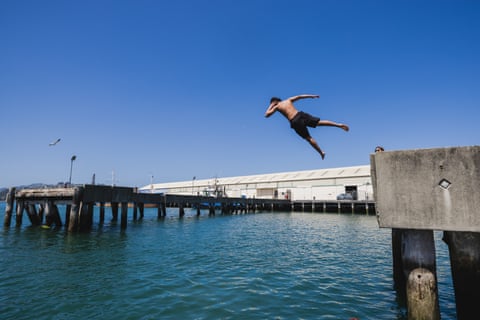Similar to a bomb, the diving style developed by Māori and Pasifika communities has become a national pastime. Over summer, a strange phenomenon plays out along New Zealand’s waterholes. Bridges, wharfs, cliffs and swimming pools throng with people readying to leap. Jumpers launch into the air, twist themselves into a v-shape – bums down, limbs akimbo – until they hit the surface, forcing water upwards in an almighty splash.
![[Nikita Hauraki, of Papamoa, competes at the Z Manu Championship qualifier round held at The Strand, Te Awanui Tauranga Harbour, Tauranga.]](https://i.guim.co.uk/img/media/819c42d5814244e20dbc484886e33c7d312c242a/0_0_3543_2363/master/3543.jpg?width=445&dpr=1&s=none&crop=none)
The bigger the splash and the more inventive the jump, the louder the cheers. These are the “manu” jumpers – people who get a thrill and sometimes compete – in the sport of manu, a unique New Zealand diving technique similar to a bomb, developed by Māori and Pasifika communities, and which has now become a national pastime.
![[Bayley Kahotea, 11, (left) learns the art of the manu from his dad Pone at Salisbury Wharf, Mount Maunganui.]](https://i.guim.co.uk/img/media/1e4ab8aa1474cba4dcb10bda20e0d1dad7e9b3d9/0_0_3543_2363/master/3543.jpg?width=445&dpr=1&s=none&crop=none)
“It’s like an unspoken cultural rule in New Zealand – whenever you’re around water and there is something to jump off, you pop a manu,” says Nikita Hauraki, 26, who has been popping manus since she was a child. “Everyone knows what a manu is, what it entails, how much hype is around it, even though not everyone has tried it out,” she says.
![[Hayden Tuhakaraina, 13, of Te Puna, practises his manu technique at Salisbury Wharf, Mount Maunganui.]](https://i.guim.co.uk/img/media/b33550798205b234d205c84fb4f2be71b61090ea/0_0_3543_2363/master/3543.jpg?width=445&dpr=1&s=none&crop=none)
Manu jumper Pone Kahotea, 34, has been doing the sport in Tauranga, on the North Island’s east coast, since he was a kid. “No matter where there are people swimming, there are people doing manus,” he says. Now, his 12-year-old, Bayley, is perfecting his technique.
![[Salisbury Wharf on the Tauranga Harbour side of Mount Maunganui is a popular gathering place for manu sessions.]](https://i.guim.co.uk/img/media/899045a7e22830fd7586ad11ff54cef8447edb3c/0_0_3543_2363/master/3543.jpg?width=445&dpr=1&s=none&crop=none)






















